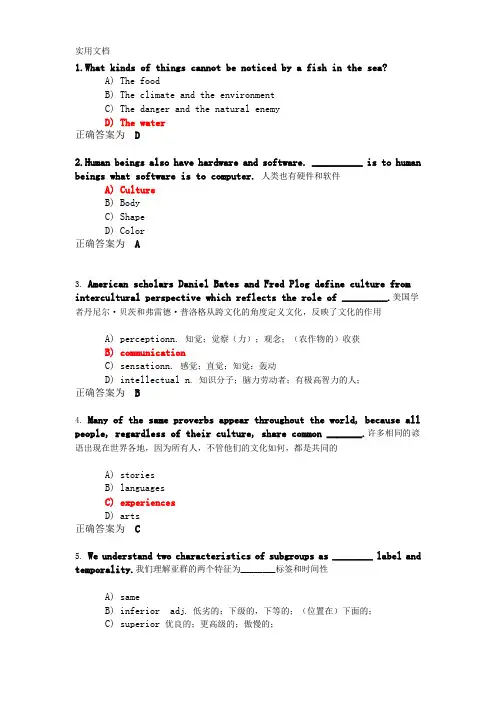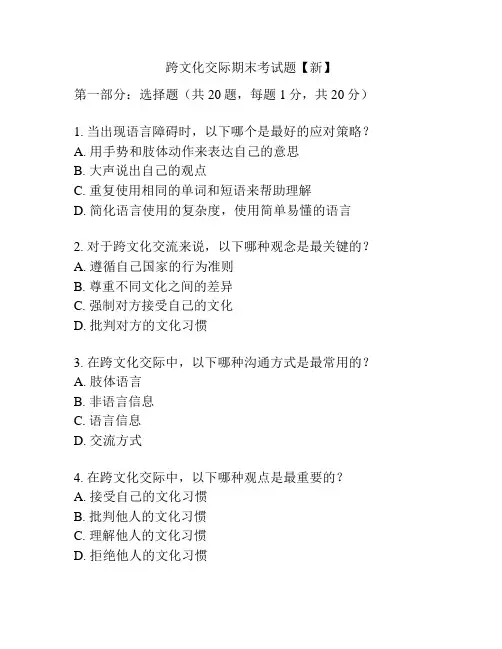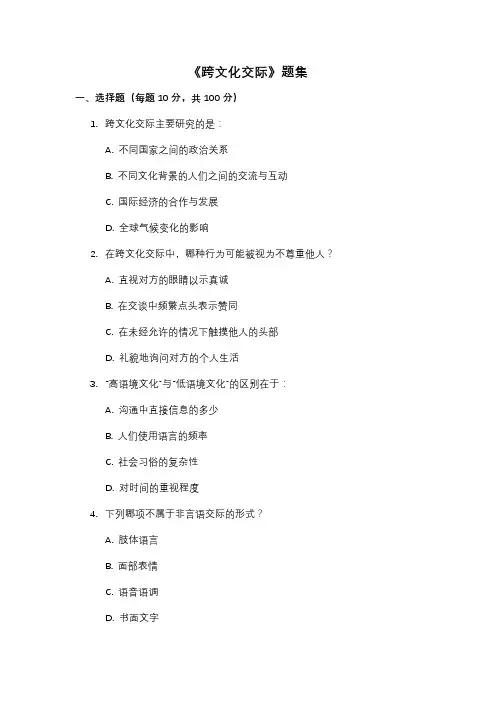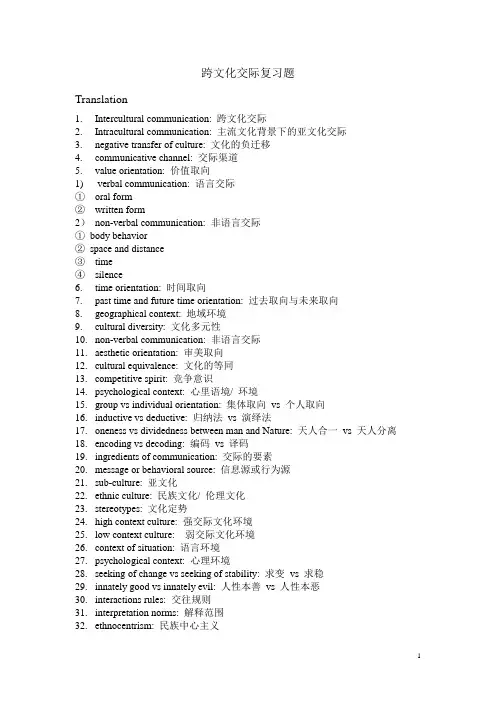(精选)跨文化交际复习题
大学生英语跨文化交际复习题库

1.What kinds of things cannot be noticed by a fish in the sea?A) The foodB) The climate and the environmentC) The danger and the natural enemyD) The water正确答案为D2.Human beings also have hardware and software. __________ is to human beings what software is to computer. 人类也有硬件和软件A) CultureB) BodyC) ShapeD) Color正确答案为A3.American scholars Daniel Bates and Fred Plog define culture from intercultural perspective which reflects the role of _________.美国学者丹尼尔·贝茨和弗雷德·普洛格从跨文化的角度定义文化,反映了文化的作用A) perceptionn. 知觉;觉察(力);观念;(农作物的)收获B) communicationC) sensationn. 感觉;直觉;知觉;轰动D) intellectual n. 知识分子;脑力劳动者;有极高智力的人;正确答案为B4.Many of the same proverbs appear throughout the world, because all people, regardless of their culture, share common _______.许多相同的谚语出现在世界各地,因为所有人,不管他们的文化如何,都是共同的A) storiesB) languagesC) experiencesD) arts正确答案为C5.We understand two characteristics of subgroups as ________ label and temporality.我们理解亚群的两个特征为________标签和时间性A) sameB) inferior ad j. 低劣的;下级的,下等的;(位置在)下面的;C) superior 优良的;更高级的;傲慢的;D) deviant 不正常的,异常的;离经叛道的正确答案为D6.__________ refers to one’s sense of belonging to a particular culture or ethnic group. It means one’s sense of the culture to which one belongs.指一个人对某一特定文化或民族的归属感。
跨文化交际期末考试题【新】

跨文化交际期末考试题【新】第一部分:选择题(共20题,每题1分,共20分)1. 当出现语言障碍时,以下哪个是最好的应对策略?A. 用手势和肢体动作来表达自己的意思B. 大声说出自己的观点C. 重复使用相同的单词和短语来帮助理解D. 简化语言使用的复杂度,使用简单易懂的语言2. 对于跨文化交流来说,以下哪种观念是最关键的?A. 遵循自己国家的行为准则B. 尊重不同文化之间的差异C. 强制对方接受自己的文化D. 批判对方的文化习惯3. 在跨文化交际中,以下哪种沟通方式是最常用的?A. 肢体语言B. 非语言信息C. 语言信息D. 交流方式4. 在跨文化交际中,以下哪种观点是最重要的?A. 接受自己的文化习惯B. 批判他人的文化习惯C. 理解他人的文化习惯D. 拒绝他人的文化习惯5. 在一个跨文化交际的场合中,以下哪个应该是最高的优先级?A. 活跃的参与B. 语言水平的熟练程度C. 适应当地的礼仪和行为准则D. 强调自己的文化背景6. 以下哪个是一个跨文化交际中最常见的问题?A. 礼貌和礼仪的不同B. 文化差异造成的文化霸权C. 认知差异的沟通问题D. 语言障碍7. 以下哪种服务最适合在跨文化交际中使用?A. 机器翻译服务B. 优先选择专业的口译和翻译服务C. 通过朋友或熟人的介绍寻找帮助D. 利用在线社交媒体解决问题8. 在跨文化交际中,以下哪种事情应该避免?A. 尊重并遵循当地的礼仪和行为准则B. 试图改变或批判当地的文化习俗C. 沿用自己的文化行为准则D. 关注当地的文化和语言细节9. 在跨文化交际中,以下哪种技巧是最有用的?A. 避免使用简单易懂的语言B. 直截了当地表达自己的观点C. 关注当地的非语言行为和信号D. 尝试使用当地的单词和短语10. 当尝试与跨文化背景的人交流时,以下哪种能力是最重要的?A. 语言能力B. 理解当地文化的背景C. 思考和行动的方式D. 批判思维11. 在跨文化交际中,以下哪个语言问题最常见?A. 不同的拼写和拼音B. 不同的语法结构和单词含义C. 方言和口音D. 礼仪和交际方式12. 在跨文化交际中,以下哪个观念是最必要的?A. 尊重当地的文化背景B. 认为自己的文化优越C. 轻视当地的命令和指示D. 批判当地文化的错误13. 在跨文化交际中,以下哪个事情是至关重要的?A. 去熟悉当地的文化和语言背景B. 寻找机会批判当地的文化习惯C. 坚持自己的文化行为准则D. 放松身心,自然而然的融入当地环境14. 在跨文化交际中,以下哪种行为应该被避免?A. 尊重他人的文化背景B. 没有认真倾听对方的观点C. 关注当地的语言和文化细节D. 对对方的文化行为进行批评和评价15. 在跨文化交际中,以下哪种观念是最重要的?A. “我们的文化最好”B. “我们的文化最好,但我们也能接受其他文化”C. “所有文化都有其独特之处,值得尊重和理解”D. “其他文化与我们的文化无关”16. 在跨文化交际中,以下哪种行为应该被避免?A. 关注和遵守当地的礼仪和行为准则B. 尝试使用当地的语言和单词C. 尊重和理解当地的文化习俗D. 批判和否定当地的文化习俗17. 在一个跨文化交际的场合中,以下哪个应该是最高的优先级?A. 展示自己的文化背景B. 关注当地的语言和文化细节C. 认真倾听对方的观点D. 强调自己优越的文化背景18. 在跨文化交际中,以下哪种事情应该被避免?A. 尊重所有人的文化背景B. 批判当地的文化行为C. 关注当地的非语言信号D. 使用当地的语言和单词19. 在跨文化交际中,以下哪种技巧是最有用的?A. 尊重当地的文化背景B. 试图改变当地的文化行为准则C. 使用自己的语言和单词D. 关注当地的微妙而又微小的语言和非语言信号20. 在跨文化交际中,以下哪种行为应该被避免?A. 关注当地的礼仪和行为准则B. 忽略当地的迷信和传统信仰C. 尊重当地的宗教和文化背景D. 沿用自己的文化行为准则第二部分:简答题(共5道题,每题4分,共20分)1. 解释什么是文化差异,并列举至少三个文化差异的例子?2. 解释为什么认知差异在跨文化交际中是一个重要的问题,并提供至少三个示例说明不同的认知差异会如何影响跨文化交流?3. 解释什么是非语言沟通,并列举至少三个非语言沟通的例子?4. 解释为什么跨文化交际中的措辞和用词是非常重要的,并提供至少三个示例说明,不同的词语和措辞可能导致文化差异。
跨文化交际复习考试题及答案

T 1 As a phenomenon, intercultural communication has existed for thousands of years. However, as a discipline, its history is only about fifty years. 作为一种现象,跨文化传播已经存在了数千年。然而,作为一门学科,它的历史只有大约五十年。
F6.We can address Jason Douglas, who is a lawyer, as Lawyer Douglas. 我们可以解决杰森道格拉斯,他是个律师,律师道格拉斯。
F_7.Chinese hospitality toward the westerners is always greatly appreciated. 中国人对西方人的热情好客是非常赞赏的。
T 4 Culture can be seen as shared knowledge ,what people need to know in order to act appropriately in a given 约定的 特定的 culture. 文化可以被看作是一种共享的知识,人们需要知道的是在一个特定的文化中扮演适当的行为
T_4.Ranks in the armed forces like Captain, Colonel can be used as titles. 上校,上校,上校,可以用作头衔
F_5.Westerners can understand what Uncle policeman or P.L.A. Uncle means. 西方人能够理解警察叔叔和解放军叔叔的手段。
T_2、Don’t take offence-getting the form of address ”wrong” is rarely intended to be offensive. 不要拿“错误”的形式来攻击,这是很难得的进攻
《跨文化交际》题集

《跨文化交际》题集一、选择题(每题10分,共100分)1.跨文化交际主要研究的是:A. 不同国家之间的政治关系B. 不同文化背景的人们之间的交流与互动C. 国际经济的合作与发展D. 全球气候变化的影响2.在跨文化交际中,哪种行为可能被视为不尊重他人?A. 直视对方的眼睛以示真诚B. 在交谈中频繁点头表示赞同C. 在未经允许的情况下触摸他人的头部D. 礼貌地询问对方的个人生活3.“高语境文化”与“低语境文化”的区别在于:A. 沟通中直接信息的多少B. 人们使用语言的频率C. 社会习俗的复杂性D. 对时间的重视程度4.下列哪项不属于非言语交际的形式?A. 肢体语言B. 面部表情C. 语音语调D. 书面文字5.在一些文化中,沉默可能被视为:A. 同意的标志B. 思考的表示C. 不尊重的行为D. 沟通的一种方式6.“文化休克”通常发生在:A. 一个人长时间处于自己的文化中B. 一个人初次接触并适应新的文化环境时C. 一个人对某种文化有深入了解之后D. 一个人在不同文化之间频繁切换时7.下列哪项是跨文化交际中常见的挑战?A. 语言障碍B. 价值观差异C. 沟通风格的不同D. 以上都是8.在一些文化中,时间被视为一种:A. 可以随意支配的资源B. 必须严格遵守的规则C. 可以用来建立社会关系的工具D. 以上都有可能是,取决于具体的文化9.“面子”在跨文化交际中是一个重要的概念,它通常指的是:A. 一个人的社会地位B. 一个人的自尊心和荣誉感C. 一个人在外貌上的吸引力D. 一个人在经济上的实力10.下列哪项不是促进跨文化交际有效性的策略?A. 增强文化意识B. 发展跨文化沟通技巧C. 避免与不同文化背景的人交往D. 尊重并适应不同的文化习俗二、填空题(每题10分,共50分)1.在跨文化交际中,__________是指由于文化差异而导致的沟通障碍或误解。
2.__________文化强调直接、明确的沟通方式,而__________文化则更注重含蓄和间接的表达。
跨文化交际

跨文化交际复习题Translation1.Intercultural communication: 跨文化交际2.Intracultural communication: 主流文化背景下的亚文化交际3.negative transfer of culture: 文化的负迁移municative channel: 交际渠道5.value orientation: 价值取向1)verbal communication: 语言交际①oral form②written form2)non-verbal communication: 非语言交际①body behavior②space and distance③time④silence6.time orientation: 时间取向7.past time and future time orientation: 过去取向与未来取向8.geographical context: 地域环境9.cultural diversity: 文化多元性10.non-verbal communication: 非语言交际11.aesthetic orientation: 审美取向12.cultural equivalence: 文化的等同petitive spirit: 竞争意识14.psychological context: 心里语境/ 环境15.group vs individual orientation: 集体取向vs 个人取向16.inductive vs deductive: 归纳法vs 演绎法17.oneness vs dividedness between man and Nature: 天人合一vs 天人分离18.encoding vs decoding: 编码vs 译码19.ingredients of communication: 交际的要素20.message or behavioral source: 信息源或行为源21.sub-culture: 亚文化22.ethnic culture: 民族文化/ 伦理文化23.stereotypes: 文化定势24.high context culture: 强交际文化环境25.low context culture:弱交际文化环境26.context of situation: 语言环境27.psychological context: 心理环境28.seeking of change vs seeking of stability: 求变vs 求稳29.innately good vs innately evil: 人性本善vs 人性本恶30.interactions rules: 交往规则31.interpretation norms: 解释范围32.ethnocentrism: 民族中心主义municative distance: 交际距离34.spatial setting: 空间场合35.temporal setting: 时间场合36.instrumental type: 工具型37.affective type: 情感型38.parataxis vs hypotaxis: 意合vs 形合39.pragmatic transfer: 语用迁移40.pragmatic failure: 交际失误41.cooperative principle: 合作原则42.politeness principle: 文明原则43.positive face and negative face: 积极面对和消极面对44.gender communication culture: 性别交际文化45.generation communication culture: 代交际文化46.professional communication culture: 职业交际文化47.proxemic behavior: 体距行为48.multicultural communication: 多元文化交际49.globalization vs glocalization: 全球化vs 全球语境下的本土化50.interethnic communication: 跨种族交际True or False1. Usually, the husband serves the cocktails and the wife clears the dishes from the table.—T2. Frequent guests often help the host and the hostess with the daily activities of the family.—T3. The guest may say a short prayer of thanks before dinner begins.—F4. A woman should not have a sustained conversation with a man in a public place in American subways.—T5. Men usually extend their hands and shake hands with women when they meet for the first time.—F6. If a woman invites a man for a date, it is usually “dutch treat”.—T7. In the United Sates, men and women can date a variety of people respectively.—T8. If you are thinking as much of others as of yourself, you won’t made mistakes that annoy others.—T9. It is not proper to talk with another person in a language unfamiliar to the rest.—T10. At the end of a speech it is sufficient to make a very slight bow without saying anything.—T11. In the United States, people find silence uncomfortable, except when it occurs between close friends.—T12. Americans think it is not very good to have acquaintance with members of the opposite sex.—F13. In the United States setting a date to get together must be done quite a few days in advance.—F14. American people like to drink tea very much after meals.—F15. American people have little concern for social rank.—T16. In conversation people never use each other’s titles.—F17. If you meet a stranger in the West and ask him the way, you should say “Hello, can you tell me the way to the bus station?”.—F18. Supposed you are asked to make a speech, you should address the listeners as “Gentlemen and Ladies” or “Mrs. and Mr.”—F19. In the West, it is not normal for a man to shake hands.—F20. The British don’t normally shake hands when taking leave unless someone is leaving for a fair length of time.—T21. While giving a lesson to your students if you want to go to the “W.C”, you say “I am sorry.”—F22. When you speak you must try to keep the tone light, casual and natural.—T23. The person who extends an invitation is usually expected to pay, though there is no definite answer to the question of who pays.—F24. When you didn’t follow the speaker, it is not polite for you to say “Repeat your words, will you?” to hi m.—T25. When invited to a party or dinner, it is very common for the guest to take bottles of drink there and give them to the host or hostess on arrival.—T26. When the dinner or party is over, you may take leave or say goodbye to the host or hostess as quickly as you can.—F27. When taking a taxi in the West, you have to tip the driver.—T28.The person who makes a call is usually the one to end the conversation on the phone.—F29. Flowers are very lovely and beautiful; you may carry any flowers when taking planes.—F30. It is necessary for you to do shopping with a basket at the supermarket in the West, before you enter the supermarket.—F31. When you dislike the price, you may say“ Sorry, the price is very high.”—F32. If you receive an invitation to a conference, you needn’t reply to it unless you attend it.—F33. For every meeting, there is an opening ceremony and closing ceremony.—F34.Dinner talks are necessary for a formal conference.—T35. Usually a dinner party will be given to the guests after signing a contract. And only the person who signs the contract will present himself.—F36. When signing a contract the assistants from both parties will sign the contract.—T37. In an opening ceremony it is polite to invite some top officer to make a speech.—FChoice1. In America it is considered better to be invited to a person’s house.2. Flowers are not provided in hotels because flowers are too expensive.3. Standing around chatting with one another is the answer to best describe Americans behavior at parties.4. Not to stay too long in one place is the basic rule at a party in America.5. You should move from group to group meeting people if you are alone at a party.6. The best way for women to meet men is in group.7. In the West it is customary for a man to raise his hat slightly off his head when he meets with a girl or a woman.8. An invitation to come to the home for a meal or a longer visit is usually given by the hostess.9. Some invitations bear the letters “R.S.V.P” That means reply as soon as possible.10. If you are waiting for someone in his room, it is all right for you to pick up a newspaper or magazine from the table to read.11. If you find it absolutely necessary to spit, go into a lavatory.12. When a man is with a lady, he usually walks behind her except when for instance, they got off a train , want to open a heavy door , try to find a table in a restaurant. 13. In the western countries when you give something to a person or receive something from a person, you should use one hand only-usually the right hand.14. That a married woman servant is called Mrs. So-and-so is a failure of communication.15. If you eat at a restaurant, you have to give the waiter a tip. You say“Thank you” and put the tip into the waiter’ hand.16. When two persons of the same sex shake hands, the older one puts his( or her) hand out first.17. That you introduce a married woman to an unmarried woman is wrong when you introduce two persons.18. You will spoil the dinner by arriving late because you will both make the other guests unhappy and make the dishes tasteless.19. A woman (not the hostess) should never rise when she is being introduced.20. As a guest at the dinner table you will not feel doubtful about which seat you should take because there is no order of importance of seats.21. If you do not enjoy the party, you must still say something to please your hostess.22. One day, when an American lady accidentally bumped into Wei Lin. Lady: I’m terribly sorry. Wei: That’ all right.23. At a bus stop, Man: Excuse me, do you know which bus to catch for London Road, please? Woman: Sorry, I’ve no idea. Man: Oh.24. Li had something to tell the manager, Mr. Smith, so he went to his place, entering the room and said” Can I have a word with you, Mr. Smith?”25. If you are attending a family gathering and would like to know what the familial relationship is between one member and another, you may ask”Is her your…?”26. When introduced to an older professor or to a friend’s parents, you would say” Hi! Glad to know you.”27. When introducing yourself to someone you don’t know at a party, you would say”Hi, I’m…”28. Jack phones Xiao Song’s office.Jack: Hello, I’d like to speak to Song Hua, please. Song: This is Song Hua speaking.29. Mr. Green’s secretary, Pat Kent, went to the airport to meet Mr. Barnes for her boss. Miss Kent: Excuse me, would you be Mr. Barnes?Q & A1. What have contributed to increased international contacts?A: New technology, growth in the world’s population, and shifts in the global economic arena have contributed to increased international contacts.2. What are the characteristics of culture?A: Culture is learned, transmitted from generation to generation, based on symbols, subject to change, integrated, ethnocentric and adaptive.3. What is interracial communication?A: Interracial communication occurs when the source and the receiver exchanging messages are from different races.4. What is interethnic communication?A: Ethnic groups usually form their own communities in a country or culture.5. What are elements of intercultural communication?A: The interacting elements fall into four general groupings: perception, verbal processes, nonverbal processes, and contextural elements.6. What is perception?A: Perception is the process of selecting, organizing, and interpreting sensory data ina way that enables us to make sense of our world.7. What factors influence human perception?A: Physical factor, environmental factor, and cultural factor influence human perception.8. Why do we say beliefs are important in intercultural communication?A: Belief systems are significant to the study of intercultural communication because they are at the core of our thoughts and actions, and they affect our conscious and unconscious minds, as well as the manner in which we communicate.9. What is value?A: Value is a learned organization of rules for making choices and for resolving conflicts.10. What is cultural value?A: Cultural values tend to permeate a culture and are derived from the large philosophical issues that are part of culture’s milieu.11. What are dominant American cultural patterns?A: Individualism, equality, materialism, science and technology, process and change, work and leisure, and competition.12. What are Hofstede’s value dimensions?A: Individualism—collectivism, uncertainty avoidance, power distance and masculinity and femininity.13. What do cultures differ in their attitudes towards?A: Individualism and collectivism, uncertainty avoidance, power distance, masculinity and femininity, human nature, the perception of nature, time, activity, relationships, context, formality and informality, and assertiveness and interpersonal harmony.14. What is world view?A: World view is a culture’s orientation toward God, humanity, nature, questions of existence, the universe and cosmos, life, death, sickness, and other philosophicalissues that influence how its members perceive their world.15. What are religious similarities?A: Sacred writings, authority, traditional rituals, speculation and ethics.16. What are the five main religions of the world?A: Christianity, Judaism, Islam, Hinduism and Buddhism.17. What different meanings toward life in five religions?A: Christianity—love, Judaism—order, Islam—authority, Hinduism—wisdom and Buddhism—suffering.18. Why is language important?A: Because we employ words to relate to the past, we use words to exercise some control over the present, and use words to form images of the future.19. What is the relation between language and culture?A: It is impossible to separate our use of language from our culture. In its most basic sense, language is a set of symbols and the rules for combining those symbols that are used and understood by a large community of people.20. What are the problems of the translation in linguistic equivalence?A: V ocabulary or lexical equivalence, idiomatic and slang equivalence, grammatical-syntactical equivalence, experiential-cultural equivalence and conceptual equivalence.21. What is nonverbal communication?A: Nonverbal communication involves all those nonverbal stimuli in a communication setting that are generated by both the source and his or her use of the environment and that have potential message value for the source or receiver.22. Why is nonverbal communication important?A: We make important judgments and decisions about others based on their nonverbal behavior. We use the actions of others to learn about their emotional states.23. What are the functions of nonverbal communication?A: To repeat, to complement, to substitute for a verbal action, to regulate and to contradict a communication event.24. What are nonverbal messages are communicated by means of?A: Body behavior, space and distance, time, and silence.。
跨文化交际试题(附答案)

Chen: This is Beijing duck, one of China's most famous dishes. You'll love it!
Luke: No, thanks. I don't like duck. I prefer chicken.
(精选)跨文化交际期末考试复习题
跨文化交际期末考试复习题Define the following items:1.Culture:On the surface: customs and behaviorMore deeply: what the behavior and customs mean to the people who are following themIn a word: Culture is all about meaningsHall: Culture is everything and everywheremunication:Communication is our ability to share our ideas and feelings.(the basis of all human contact)3.intercultural communication:Intercultural communication is communicationbetween people whose cultural perceptions and symbol systems are distinct enough to alter the communication event.intercultural communication refers to any communication between two members of any cultural communities.4.high-context culture:In high-context messages, meaning is not necessarilycontained in words. Information is provided through gestures, the use of space, and even silence. Meaning is also conveyed through status (age, sex, education, family background, title, and affiliation).5.low-context culture:In low-context messages, the majority of the informationis vested in the explicit code.6.relationship between culture and language:7.verbal communication8.analytical thinking patterns (inductive)9.synthetic thinking patterns (deductive)10.nonverbal communication:Nonverbal communication involves allnonverbal stimuli in a communication setting that is generated by both the source and his or her use of the environment and that has potential message value for the source or receiver11.body language:Body language refers to all nonverbal codes which are associatedwith body movements.Body language includes gestures, head movements, facial expressions, eye behaviors, postures and other displays that can be used to communicate.12.monochronic time (M Time) :It schedules one event at a time. In thesecultures time is perceived as a linear structure just like a ribbon stretching from the past into the future.13.polychronic time (P Time):P-time schedules several activities at the sametime. It is more flexible and more humanistic.People from P-time system emphasize the involvement of people more than schedules. They do not see appointments as ironclad commitments and often break them.14.ethnocentrism:the view of things in which one’s own group is the center ofeverything, and al l others are scaled and rated with reference to it” (WilliamG. Sumner)15.stereotypes:Stereotypes are a form of generalization about some groupof people, or a means of organizing images into fixed and simple categories that are used to stand for the entire collection of people 16.prejudice: It refers to negative attitudes towards other people that arebased on faulty and inflexible stereotypes.It is an unfair, biased, or intolerant attitude towards another group of people. ( Lusting & Koester)17.discrimination:It refers to the behavioral manifestations of theprejudice, it can be thought of as prejudice “in action”. ( Lusting & Koester)18.racism:19.culture shock:Troublesome feelings such as depression, loneliness,confusion, inadequacy, hostility, frustration, and tension, caused by the loss of familiar cues from the home culture. (Linell Davis)20.acculturation:It is culture change that results from continuous firsthandcontact between two distinct cultural groups.It is through acculturation that personal transformation from cultural contact takes place.Acculturation includes psychological, physiological and social changes.Essay Writing1.Describe your personal intercultural experiences in about 300-500words.2.From the perspective of intercultural communication, analyze thefollowing movies.(1)Joy Luck Club(2)Guasha(3)Crash(注:专业文档是经验性极强的领域,无法思考和涵盖全面,素材和资料部分来自网络,供参考。
跨文化交际专业试题及答案
跨文化交际专业试题及答案一、选择题1. 跨文化交际中,以下哪个行为最可能被视为不礼貌?A. 直接注视对方B. 握手C. 鞠躬D. 保持微笑答案:A2. 在美国,人们通常在什么情况下会使用“please”?A. 要求别人做事B. 表达感谢C. 表达歉意D. 表达同意答案:A3. 在日本,以下哪种行为被认为是尊重的表现?A. 直接进入别人的办公室B. 敲门并等待允许C. 未经允许就坐下D. 直接打断别人说话答案:B4. 在阿拉伯文化中,握手时通常不包括以下哪个动作?A. 用右手B. 保持眼神接触C. 持续时间较长D. 同时用左手触碰对方答案:D5. 在中国文化中,赠送礼物时以下哪个行为是不恰当的?A. 包装礼物B. 赠送钟表C. 赠送书籍D. 赠送鲜花答案:B二、简答题1. 描述跨文化交际中非言语交流的重要性。
答案:非言语交流在跨文化交际中起着至关重要的作用,因为它可以传达情感、态度和文化背景。
非言语交流包括肢体语言、面部表情、眼神交流、声音的音调和节奏等。
不同的文化对这些非言语信号有不同的解读,因此理解和正确使用非言语交流对于跨文化沟通的成功至关重要。
2. 解释文化冲击是什么,并给出一个例子。
答案:文化冲击是指一个人在进入一个新文化环境时,由于文化差异而经历的心理和情感上的困惑、焦虑和不适。
例如,一个习惯于个人主义文化的西方人,当他第一次来到一个强调集体主义的亚洲国家时,可能会对那里的团队合作和群体决策感到不适应,从而经历文化冲击。
三、论述题1. 论述在国际商务环境中,了解和尊重不同文化的重要性。
答案:在国际商务环境中,了解和尊重不同文化对于建立和维护商业关系至关重要。
首先,了解不同文化可以帮助我们更好地理解商业伙伴的行为和期望,从而避免误解和冲突。
其次,尊重文化差异可以展示我们的开放性和包容性,这有助于建立信任和尊重,是长期合作关系的基石。
此外,跨文化交际能力也是全球化时代商务人士的重要技能,能够帮助企业在多元文化市场中取得成功。
《跨文化交际》试题(附答案)
《跨文化交际》试题(附答案)Paper 1 Communication AnalysisThe following are three different cases of cross-cultural communication. In each of the cases there is something to be improved upon. Write an analysis on what is to be desired for more successful communication or cultural understanding.Question 1Case 1:Chen Bing, a Chinese tour guide, is talking to a Canadian tourist, Luke Baines, who has no knowledge of Chinese at all. They are having dinner in a restaurant.Chen: This is Beijing duck, one of China's most famous dishes. You'll love it!Luke: No, thanks. I don't like duck. I prefer chicken.Question 2Case 2:Feng Li and Tom have been working on a scientific experiment at a British university for some months. It has not been totally successful. They are discussing the situation in the laboratory.Feng Li: I don't know where it went wrong!Tom, Don't feel so bad. Cheer up, you've done your job.Feng Li: But our experiment has turned out to be a failure.Tom: Relax for a couple of days. I'll face the music.Feng Li: Tom, we are not playing children's games here. This is a scientific experiment.Tom, I've never taken the experiment as child’ s play, and I'm playing the game.Feng Li: You say you're playing the game! It's a rather important experiment!Feng Li walks out of the Laboratory angrily. Tom is puzzled.Question 3Case 3:This is a more complex situation where there are several things that require more informed cultural analysis. Find the cultural problems and explain the cultural differences. Jim and Li Zhen were students together at Leeds University in Britain. A year later, after graduating, Jim went to Shanghai as a visiting scholar on a year’s exchange.Jim had never been to China before. Li Zhen took him to a classical pianoconcert performed by a famous Chinese pianist. During the performance people were talking and at one stage someone ran up onto the stage and presented the pianist with a bunch of flowers during the playing of a particular musical item. This happened several times during the evening. It also happened when two singers were on stage singing some songs that he was playing. Jim thought all these things quite strange. At the end of the performance the audience applauded the pianist and he applauded them. The audience began to leave while the pianist remained on the stage.Paper 2 VocabularyChoose one word or expression from those in the box below to fill the gap in each of the sentences. Write the correct words in the spaces provided in your answer sheet. Do not change the forms of the4. After twenty five years working in the bank she decided on a different .5. Finally, after arguing about the meal for five minutes it was decided he would .6. Despite the circumstances of the accident there were still some that needed explanation.7. There are many different used when talking about people's relationships in China.8. "Mike! Meet Jane, the ."9. "Ok, the argument is over. Let's forget it, you know."10. People in English speaking countries also avoid losing face or hurting other people by telling .11. It is difficult for foreigners to understand British pub culture, especially the system of which all members of the group are expected to join in.12. It was a crushing blow to her, a hit when she received the news that her husband had left her for another woman.13. In China there is a real sense of in social situations. Paper 3 TranslationTranslate the following passage from English into Chinese. Please write your translation on the answer sheet.What do we mean by "Intercultural Communications" or "IC"? This is not a description of the popular trend toward talking about international things or going overseas. IC is actually an academic and applied discipline that has developed internationally since the 1950s. Sometimes called "cross-cultural communications" or "comparative culture" , scholars most often use the prefix "inter" with the word "cultural" to describe the interaction between cultures. On one level, IC is represented by culture studies, where we examine the political, economic and lifestyle systems of other countries. On another level, it is applied linguistics, where we seek to understand the relationship between language and culture. Many Chinese English teachers and professors have been interested in this aspect since the 1980s - How to teach English in ways that help students also learn the basic communication practices of Britain, the US or other English speaking countries.But the discipline of Intercultural Communications is actually a broad and well-developed field of study. IC is an interdisciplinary application of fields like cultural anthropology, sociology, psychology (and social psychology), communication studies, applied linguistics and educational pedagogy. IC is a comprehensive attempt to understand all aspects of human cultures and how they interact with each other.To understand Intercultural Communications, we seek to understand tradition and modernization, consistency and change. As we understand some of the ongoing national characteristics of a people, we can examine how this culture is seen from the outside, how it interacts with other cultures and how it is changing. In the last thirty odd years, scholars have developed both theoretical framework for comparing cultures and some practical dimensions for considering the similarity and differences between them. One level of intercultural comparison is Cultural Identity. Another level of comparison is Verbal Communication. Another area receiving much attention is Nonverbal Communication. Paper 4 ReadingPassage 1 Questions 15-20In recent years criticisms have been voiced concerning sexist bias in the English language. It has been argued that some of the vocabulary and grammar we use reflects and reinforces a traditional view of the world as one in which men are dominant and women play a secondary role. Takethe word 'chairman' for example. While this can in fact apply to people of both sexes, it appears to some people to be male-oriented as it ends in 'man'. In the past people taking the role of chairman were exclusively male and the word was obviously originally a compound of 'chair' and 'man'. Many English speakers, however, have ceased to view this word as a compound and no more feel it to be composed of these two units, than they perceive cupboard to be a composite of ' cup' and ' board'. In addition the continued use of chairman might be defended on the grounds that the final syllable is pronounced /m'n/ rather than /mn/, just like the final syllable of woman. Despite such considerations other speakers take a contrary view and are sensitive to the components of which it is made up. They clearly perceive it as a title that perpetuates traditional ideas about the place of women in society. For this reason they seek to replace it with neutral terms such as 'chairperson' or 'chair', so that it is now possible to ask questions such as; 'Who is chair of the committee?' Other changes advocated include the replacement of words such as 'postman', 'fireman' and 'policeman' with more clearly neutral terms such as 'postal worker', fire-fighter' and 'police officer’. There is, however, continuing controversy about how far such language changes should go. Should changes be considered for traditional idioms as 'man in the street' and titles such as 'Peking Man'? What about those words where the male meaning of 'man' is no longer dominant, such as 'manhandle'?To the extent that changes have taken place, they have done so more in the written language and formal pronouncements than in everyday speech. You would be quite likely to read in the paper that 'Postal workers are to receive a pay increase.' But 'Has the postman been?' would be most likely to be heard in informal conversation. Here 'postma n’ remains firmly entrenched in popular usage.The extent to which language reflects and shapes attitudes and behaviors is a matter of conjecture. Chinese, Japanese, Persian and Turkish do not make the kinds of sex distinctions English makes through its system of pronouns, but it would be difficult to maintain that males who speak these languages are less sexist than males who speak English! Answer the following questions according to the above text:15. The general use of the word 'man' added to English words indicates .A. sexual feelingsB. sexual freedomC. sexist ideasD. sexist bias .16. Generally where language and sex are concerned in Britain .A. all people agree change is neededB. some people agree change is neededC. people can't make up their minds on the issueD. people think the issue is unimportant and not serious17. What example does the author give to support a defense of the word 'chairman'?18. What does the author argue for when the example 'manhandle' is given?19. What does the author have to say about the impact of language changes?20. What is the author's argument in the final paragraph?Passage 2 Questions 21-27Can Computers Do a Better Job Rating Stocks?Since May, Charles Schwab has been providing stock ratings to clients using a computerized system that it says tries to remove human bias.In particular, Schwab says, its system is meant to avoid the conflicts of interest that have plagued traditional brokerage firms, whose research analysts have often acted as cheerleaders for companies being courted by their investment bankers."We believe that our single biggest advantage is our objectivity," said Jerry Chafkin, Schwab's executive vice president for investment advice and products. " While the development of the methodology is human, the analysis is being performed systematically and automatically.Though Schwab is perhaps the most prominent financial services company to use a computer-driven rating system, several others, including Value Line and Zacks Investment Research, pick stocks in a similar way.The various systems produce very different ratings of individual stocks, and their ability to outperform a market index fund over time has not been proved conclusively. The verdict is still out as to whether computers do it better than people. What is clear, though, is that the major computerized systems hand out fewer positive stock ratings than do Wall Street analysts, who seem to give them out very generously.People who run computerized selection systems criticize traditional Wall Street analysis as having institutional conflicts of interest, as well as individual bias. "I am very suspicious about opinions and judgments and emotions by humans in individual stock selection," said Samuel Eisenstadt, Value Line's research director.However, the computer-driven stock-picking systems must rely on the selection criteria of their creators. All try to isolate factors that their developers believe have the greatest ability to predict share prices. Most models compare a company9s historical earnings growth with that of other companies. And many track the extent to which earnings have surprised analysts.Many firms use their computer-based stock-rating systems as marketing tools.The designers of these systems say they should be judged on how a group of stocks performs over time. But all the systems assume, as do stock analysts on Wall Street, that superior research, by humans, and analysis can select a group of stocks that will outperform the market averages over the long run.Market analysts say it is too soon to assess the fledgling Schwab system or new models, like Microsoft's year-old Stock-ScouterMark the following statements True (T) / False (F) / Not Given (NG) according to the information provided in the text.Write T, or F or NG on your answer sheet in the spaces provided for questions.21. Charles Schwab is a computer company.22. The method of operation by Schwab is done automatically.23. 'Value Line' and 'Zacks' have similar operating methods to Schwab.24. There is no conclusive proof that computers perform better than humans.25. Wall Street analysts are generous in rating stocks.26. Human beings make value judgments according to the research director of 'Value Line'.27. Analysts are surprised at the growth rate of share prices.答案及评分标准Paper 1: Communication Analysis●The following points should be covered in the analysis.●Award one point for each of the points covered (underlined). Paper 2: Vocabulary●One point for each item.●Answers must be the same as the key.4. vocation5. foot the bill6. grey areas7. kin terms8. trouble and strife 9. live and let live10. white lies 11. buying a round12. below the belt 13. communityPaper 3: Translation14.“跨文化交际”或“IC”是指什么呢?这并不是对于谈论国际事务或出国大潮的描述。
跨文化交际试题及答案
跨文化交际试题及答案一、选择题(每题2分,共40分)1. 跨文化交际的定义是指:A. 不同国家和地区间的交际活动B. 不同民族和文化背景间的交际活动C. 同一文化内部的交际活动D. 不同语言之间的交际活动答案:B2. 文化差异会对跨文化交际产生以下哪种影响?A. 理解困难B. 语言障碍C. 价值观冲突D. 人际关系紧张答案:A、C3. 在跨文化交际中,以下哪种行为被认为是失礼的?A. 目光接触B. 握手问候C. 低头鞠躬D. 打招呼时用双手表示敬意答案:C4. 在中国文化中,以下哪种颜色象征喜庆和幸福?A. 黑色B. 红色C. 绿色D. 白色答案:B5. 在进行跨文化交际时,以下哪种策略是最有效的?A. 强调自己的文化优势B. 忽视文化差异C. 遵守对方的文化规范D. 强迫对方接受自己的文化观念答案:C二、简答题(每题10分,共30分)1. 请简要阐述跨文化交际的重要性以及其中存在的挑战。
答案:跨文化交际的重要性在于增进各国间的相互了解和友谊,推动跨国合作和发展。
然而,跨文化交际也面临着重重挑战,如语言沟通障碍、文化差异带来的不解和冲突,以及对他人观点和习俗的理解困难等。
2. 在国际商务谈判中,如何合理利用非语言交际手段?答案:在国际商务谈判中,非语言交际手段可以帮助加强沟通效果。
可以通过身体语言表达自信和诚意,比如坐姿、目光接触和手势运用等;可以通过服饰和礼仪来展示对对方文化的尊重;还可以通过图表和演示文稿等视觉媒介来辅助表达和说明。
3. 请简要解释文化冲突是如何产生的,并提出解决文化冲突的建议。
答案:文化冲突是由于不同文化之间的差异而产生的,当个体或群体面对不熟悉的文化规范和价值观时,可能会感到困惑和不满。
为解决文化冲突,建议应采取以下措施:学习和了解对方文化,加强跨文化交际能力;尊重差异,避免对他人价值观的评判和偏见;建立良好的沟通渠道,积极解释自己的观点并倾听对方的意见;寻求共同利益和双赢的解决方案。
- 1、下载文档前请自行甄别文档内容的完整性,平台不提供额外的编辑、内容补充、找答案等附加服务。
- 2、"仅部分预览"的文档,不可在线预览部分如存在完整性等问题,可反馈申请退款(可完整预览的文档不适用该条件!)。
- 3、如文档侵犯您的权益,请联系客服反馈,我们会尽快为您处理(人工客服工作时间:9:00-18:30)。
跨文化交际复习题:
1、跨文化交流障碍产生的原因有哪些?
2、试用霍夫斯泰德的文化价值理论来分析中美课堂的主要差异及原因。
3、试分析电视剧《小爸爸》第32集中(法庭审理)体现出的主要中美文化
差异。
4、试简要叙述文化的“洋葱论”和“冰山论”。
5、请简要阐述跨文化敏感度发展模式的6个阶段。
6、非言语交流方式有哪一些?列举几个国家非言语交流方式含义的差异。
7、国际礼仪的基本原则有哪些?
8、国际惯例、本国礼俗与入乡随俗之间的关系如何处理?请举例说明。
9、什么是着装的TPO原则?
10、简述男士西装与女士套裙的着装规范。
11、见面介绍与行握手礼应遵从什么顺序?
12、名片的使用有哪些注意事项?
13、西餐的餐桌礼仪包含哪几个方面?试简述每一方面的主要规范。
案例分析题:
一、请运用非语言沟通的知识来分析以下案例。
【案例1】
Mark因为工作的原因从丹麦搬到悉尼做销售人员。
三周后,他被邀请加入一个当地的俱乐部。
最初的几周里,他总是要么坐在沙发里听别人聊天,要么站在角落里与人交谈,慢慢地他熟悉了俱乐部里的所有人。
一天,在一个晚间聚会上,一位俱乐部女性成员走近他,他们开始很有兴致地谈论晚会的气氛。
刚开始,
谈话的气氛很好,可是慢慢地Mark发现,这位女士正在慢慢地后退。
她看上去明显很不安。
正当Mark想跟她谈论一下澳洲人的风俗时,一位不远处的男士看了那位女士一眼,她如释重负地走过去开始和那位男士聊起来,留下Mark一个人疑惑地站在那里。
二、请用单一制时间观和多元制时间观来分析以下案例:
【案例2】
德国外教Nowak经常去一中国菜摊买菜,因为她的摊子品种多、态度好。
这天他挑好了一颗西兰花,正犹豫再买点什么,听到摊主又在招呼其他顾客,他等了一会儿。
只见摊主手脚麻利地给其他两个刚来的顾客过称、装袋、收钱。
好容易轮到他,摊主一边为他称菜,一边又在试图招呼其他人。
Nowak不高兴地说:“我是先来的,你应该先服务好我。
”摊主笑着回答:“我看你半天没吱声,以为你还想挑点什么呢。
我这不来了吗?!”Nowak回家的路上,一直觉得自己在这里是“老外”,太容易被人欺负了。
三、请用个体主义和集体主义价值观来分析以下案例:
【案例3】
飞利浦照明公司某区人力资源副总裁(美国人)与一位被认为具有发展潜力的中国员工交谈,想听听这位员工对自己今后五年的职业发展规划及期望达到的位置。
中国员工并没有正面回答问题,而是开始谈论起公司未来的发展方向、公司的晋升体系,以及目前他本人在组织中的位置等,讲了半天也没有正面回答副总裁的问题。
副总裁有些大惑不解,没等他说完已经有些不耐烦了,因为同样的事情之前已经发生了好几次,“我不过是想知道这为员工对于自己未来五年发展的打算,想要在飞利浦做到什么样的职位罢了,可为何就不能得到明确的回答呢”谈话结束后,副总忍不住向人力资源总监抱怨道,同时受到压力的员工也向总监诉苦,“这位老外怎么这么咄咄逼人?”作为人力资源总监,他明白双方之间不同的文化背景及由此引发的不同的沟通方式引起了隔阂,虽然极力向双方辩解,但要完全消除已经产生的问题却并不容易。
四、自行寻找案例,用中西思维方式的差异分析中西写作表达习惯的差异。
(注:专业文档是经验性极强的领域,无法思考和涵盖全面,素材和资料部分来自网络,供参考。
可复制、编制,期待你的好评与关注)。
